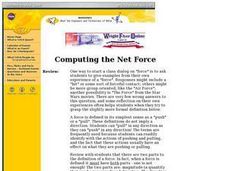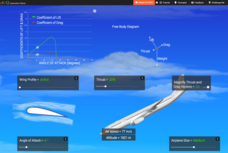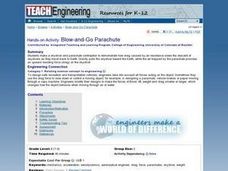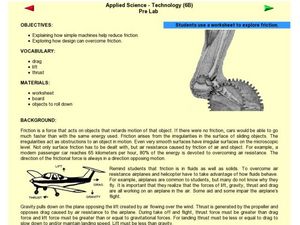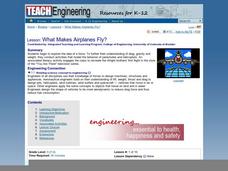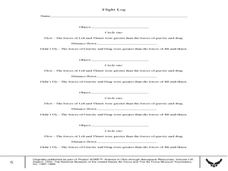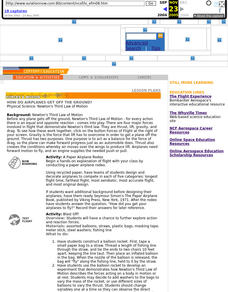Teach Engineering
May the Force Be With You: Lift
Get the class up and going with a instructional activity that discusses how airplane wings provide lift. Pupils use their knowledge of Bernoulli's Principle to develop an explanation of how it creates lift on airplane wings.
Curated OER
Computing the Net Force
Adorable little stick figures push and pull a cart of blocks to explain the push and pull of forces. Future physicists then define force and identify it in different situations on the learning exercise that follows. Concepts covered...
CK-12 Foundation
Airplane
How does an airplane control its take off and descent? Scholars explore the forces acting on an airplane and control the angle of attack, wing profile, thrust, and airplane size. They learn about lift, drag, thrust, gravity, and the...
Curated OER
Blow-and-Go Parachute
Young scholars design a skydiver and parachute constraption to demonstrate how drag caused by air resistance slows the descent of skydivers as they travel back to Earth. They experience how gravity pulls the skydiver toward the earth and...
Curated OER
How the force of air helps an airplane fly.
Students appropriately the following terms in sentences: drag, thrust, gravity, aerodynamics and lift.
Curated OER
Crash Course in Flight
High school physicists demonstrate Bernoulli's Principle by blowing on different items and finding that they do not move in the expected direction! They apply Bernoulli's equation to the flight of an airplane. This well-organized lesson...
Curated OER
Parachutes: What a Drag
Sixth graders make 2 different kinds of parachutes and record and graph the time for each one for the different drag forces. For this parachute lesson plan, 6th graders compare the results to the rest of the class of each parachute and...
Curated OER
Does Shape Affect Drag?
Students study drag and how it affects a parachute in the sky. In this parachutes instructional activity students build models and compare their drag.
Curated OER
Understanding the Four Forces of Flight
In this four forces of flight worksheet, students read a 1 page article on flights, answer 5 questions with multiple choice answers, draw a line to connect the four forces to their definitions and answer 1 short answer scenario.
Curated OER
Four Forces of Flight
Young scholars explore the four forces of flight. They investigate the four forces of flight: lift, drag, thrust and weight (gravity). They experiment with flight-testing various objects commonly found around the house and constructing...
Discovery Education
Jets in Flight
This Discovery Education activity provides the information needed to understand the basics of flight. Before taking off, young pilots learn the eight stages of the engineering design process. Small groups then design and build...
Curated OER
Applied Science -Technology (6B) Pre Lab
Sixth graders discuss how simple machines overcome friction. In this simple machine lesson, 6th graders review the parts of a plane and how they make up for gravity and friction. They roll different objects down an inclined board...
Curated OER
Flight
Students are introduced to the four forces of flight--drag, lift, thrust, and weight--through a variety of fun-filled flight experiments. They "fly" for short periods and evaluate factors that might either increase or decrease their...
Curated OER
What Makes a Kite Fly?
Ninth graders compare the nature of forces of gravity, lift, thrust, and drag. They select proper materials for making a kite and attach a proper tail. Students interpret and summarize the observations made during the flight of the kites.
Curated OER
Airplanes
Fourth graders experiment with gravity and lift by building paper airplanes. In this physics activity, 4th graders compare the falling rate of a crumpled vs. flat sheet of paper. Then after class discussion and demonstration of...
Teach Engineering
Adapatations for Bird Flight - Inspiration for Aeronautical Engineering
It's a bird, it's a ... device made to mimic birds. The eighth installment of a nine-part module has pupils read various articles to learn about bird flight. They consider the implications for aeronautical engineering.
Curated OER
Aerodynamics
Students discover the basic principles of aerodynamics, including the roles and identity of natural forces involved. They examine how the force of gravity is overcome by the curved shape of an airplane wing and air pressure.
Curated OER
Testing and Refining Aircraft Design
High schoolers design and make a flying device. They work in small groups to brainstorm ideas for the design of their device. They choose an idea or combination of ideas to use for their design and create a sketch of their design. The...
Curated OER
What Makes Airplanes Fly?
Students examine force and conduct activities that model parachutes and helicopters. In this airplanes lesson students identify the forces that make airplanes fly higher and land.
Curated OER
Paperplane Flying Circus
Students create paper airplanes. They compare and contrast the airplanes created in class and test them out. They adjust their airplanes until they all fly. They discuss the forces that allow flight to occur.
Curated OER
Gliders
High schoolers design and build a small glider. They see how the flight of a bird is similar to the flight of a sailplane. They explain how birds get their thrust and how they control their direction of flight.
Curated OER
How do engineless planes stay aloft?
Fifth graders explore how a plane can stay aloft. In this engineless airplane flying lesson plan, 5th graders experiment to find how the design of a plane and Bernoulli's principle keep planes in the air. Student's create a plane and...
Curated OER
Household Things that Fly and Why!!!
Learners examine the four forces of flight. In this flight lesson, students test to see which types of items will fly. Learners make predictions on whether the item will fly or not. Students gain knowledge about lift, gravity, thrust and...
Curated OER
How Do Airplanes Get Off the Ground
Students construct various types of paper airplanes, exploring action and reaction forces by conducting a paper airplane rodeo. Students then discuss how Newton's Third Law of Motion affected their planes.



